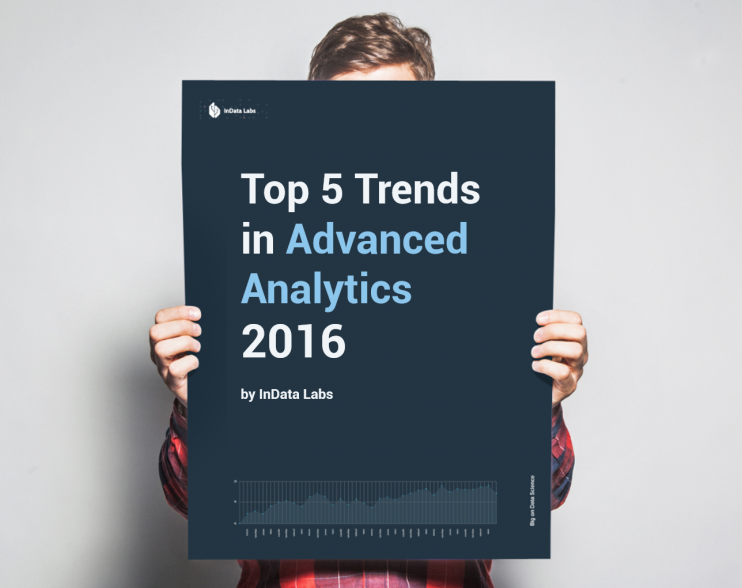As any other area with growing popularity – Advanced Data Analytics is undergoing a number of certain changes and developments. In this article we combined the Advanced Analytics Trends that we find to be the most defining and shaping for the industry in its current state.
1. Increase in adoption of advanced analytics
According to Advanced Analytics and Big Data Adoption Report by Dell, 71% of firms actively use analytics in everyday decision-making, or have plans to do so in the near future. The reason is simple, Big data analytics helps organizations make strategic decisions based on powerful insights generated by data analysis. Organizations have shifted from simple statistical analysis to more advanced analytics, which allows them to predict future events and outcomes.
Enterprises are increasingly collecting historical data to focus on predicting future trends. The demand for predictive analytics is expected to grow further in the future. Predictive analytics allows organizations to minimize risk, identify fraud, and pursue new opportunities to generate revenue. For instance, retail organizations are using situation-based analytics and pattern-based analytics to gain insights into consumer behavior, they use these insights to create customer-driven marketing strategies. Therefore, most of the organizations have increased their adoption of advanced big data analytics to achieve desired future outcomes.
2. Moving from “Big Data” to “Smart Data”
It is worth mentioning that data usage in majority of the industries is cyclical. For example, it wasn’t long ago, when retailers and bankers were trying to use all the available sources to get the data about their customers and borrowers. However, now we are witnessing a clear shift from quantity to quality of data, which could be also called “a shift from big data to smart data”. According to IIA, only 1 in 5 companies utilizing advanced analytics report actually utilizing high volume or high velocity data commonly associated with Big Data. Instead, the majority of firms seem to have their hands full with their own internal data.
Such a shift is a natural process for the development of a relatively young technology. Having lots of data is no longer enough or even necessary. The key is to seriously question the data – is the data uniform and regular? Can it be easily extracted and analyzed? Is there a significant amount of variation?
The collection and exploitation of data is meaningful only when it is used to optimize and automate solutions and solve problems (data-driven decision-making).
3. Growth of Social Media
Social media has become a major source of customer data. The availability of online conversations offers organizations unprecedented access to consumers’ opinion about their products and attitude towards their brand.
With the emergence of social networks, there is a growing demand to analyze customer behavior on social media. Organizations have realized the need to enrich their CRM systems with customer insights from social media. Therefore, companies start to invest actively in social listening tools and platforms for advanced social media analytics. This is one of the advanced analytics trends that will definitely keep growing in 2016, so keep an eye on it.
4. Personalization is the key to improving customer experience
The number of touch points between an organization and its customers has significantly increased. The ability to integrate and understand all the meaningful information about the customer from both internal and external sources is crucial for an organization that strives for customer satisfaction and loyalty, better engagement, and higher revenue.
Advanced analytics will enable organizations to achieve an unprecedented understanding of their customers – to gain a so called 360 Degree View of the Customer. It means that after the adoption of advanced analytics organizations will be able to create a highly personalized experience and shift to one-on-one relationships with their customers.
5. “Real-time” Analytics comes first
More and more enterprises are using real-time data analytics to make faster decisions and stay ahead of their competitors. So far, most analytics engines have been used for data that has been collected and stored beforehand, only to be analyzed in future – after the product launch, for example, most of the time a day or so after – providing insights about the past. But increasingly, companies are choosing real-time data analytics solutions that look into the present – at any given moment.
Real-time data systems can provide information about activity on a network within seconds – depending on how sophisticated or involving the analysis part is, which improves customer experience significantly.
Conclusion
The number of emerging Advanced Analytics Trends are only an indicator of high interest and demand towards such solutions among players in all the business sectors. The only thing is clear – Advanced Analytics is here to stay, so we expect more and more Advanced Analytics Trends to emerge in the industry.
InData Labs mission is to guide our partners through the obstacles that data analytics may cause and make this journey easy and beneficial.
Want to learn more about advanced analytics? Subscribe to our blog and get tips to move your business forward in big data analytics straight to your inbox.
Want to start getting value from your data? Let’s talk.



